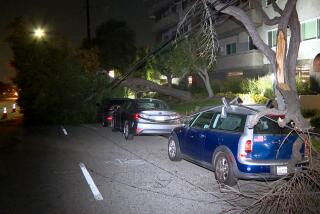High winds aren’t over yet
- Share via
A major windstorm blew into Southern California on Friday, causing a chain-reaction crash on the road to Las Vegas that killed two people, downing scores of trees and utility lines and leaving more than 100,000 homes without power.
Late Friday, wind gusts of 62 mph were reported in the Malibu hills and 38 mph in the Newhall Pass. Utility officials said power outages continued throughout the evening and at one point they were unable to verify all the locations affected.
Weather forecasters said the windstorm, which was expected to continue through today, was among the fiercest they’ve seen in years, with gusts of more than 80 mph in mountain passes and more than 40 mph at UCLA, Pasadena and other places.
The California Highway Patrol said a severe wind and dust storm near Barstow caused a crash in which a minivan hit a tour bus, killing a 56-year-old Erlinda Flores of Lake Elsinore and her 13-year-old grandson, Sean Rankin, in the van and leaving others with severe injuries.
Officials said the accident, which also involved two other vehicles, occurred about 9:40 a.m. as a dust storm from the desert reduced visibility to nearly zero on Interstate 15.
California Highway Patrol Sgt. Jeff Arnswald passed through the area shortly before the crash and later responded to the accident.
“When I came through [after the crash], the visibility was nonexistent. There was just sand everywhere,” Arnswald said. “I had been there just 20 minutes earlier, and there was no sand and everything was clear.”
The dust storms prompted some Las Vegas-bound drivers to pull off the road.
“We are trying to get to Vegas, but the car started swaying pretty bad on the freeway,” said Jason Finnegan, 47, of Temecula, waiting out the weather at a Yermo diner. “This is really as bad as I’ve seen it out here.”
Across the Southland, residents woke up Friday to stacks of palm fronds on the ground, downed trees and other debris. The wind hobbled the morning commute, as the Grapevine was jammed because of wind and icy conditions and several big-rigs toppled or jackknifed on freeways across the region.
“No alarms, you can’t cook and you have a screaming kid because you have no TV,” complained Carlos Alvarado, 43, about the wind that knocked out power to his Los Feliz home. “We had cold cereal. The milk wasn’t warm yet. All the phones were out, but luckily we had our cellphones.”
Others took the weather in stride.
At his wind-swept Malibu Park home, Marshall Thompson, 48, said the gusts have been a mixed bag. On the one hand, they blew his patio furniture over a 4-foot chain-link fence and into the next yard.
But they also swept clean his backyard, something Thompson doesn’t altogether mind.
“The wind polished the ground,” he said. “The wind giveth and the wind taketh away.”
Wind blew off a portion of the fence at the Santa Anita Race Track, causing officials to halt training for the day.
Although the storm brought little rain, snow levels dropped to about 3,000 feet, and forecasters said the cold Santa Ana winds would continue today before slowly dying down.
William Patzert, a meteorologist for the Jet Propulsion Laboratory in La Canada Flintridge, said the winds rode on a “jet stream on steroids” from the north for the second time in eight days.
Wednesday started out pleasantly enough, with the jet stream curling like an upside-down question mark, pulling warm southerly wind breezily up the coast and into the region.
That changed Thursday. The low-pressure system turning counter-clockwise continued to move east, and suddenly the wind shifted, blowing frigid and dry from the northeast. The result: cold, blow-drying Santa Anas with even more bite than the last time around.
December and January are normally strong Santa Ana wind months. But in recent years, they had not been as frequent or vigorous as before, Patzert said.
As a result of the drying effect of the winds, the National Weather Service once again declared a red flag warning because of fire danger.
In response, the L.A. County Fire Department placed 100 additional firefighters in vulnerable areas.
The gusty winds kept tree removal and trimming crews busy, even though clearing fallen limbs can prove dangerous when the wind is still blowing hard.
“We saw a lot of fallen trees, split trees, falling branches,” said Jesse Uribe, an employee at Tony Macias Tree Experts Co. in Glassell Park. “It’s definitely more dangerous in these types of conditions. At any given moment, a branch could fall.”
The winds caused dangerous surf conditions, with breakers up to 14 feet on some beaches in San Luis Obispo and Santa Barbara counties, and up to 10 feet at some beaches in Ventura and L.A. counties.
The one thing this winter’s storms failed to bring in was what forecasters said dry Southern California needed the most: significant rain.
Trace amounts kept the rainfall total since July 1 in downtown L.A. at 1.31 inches, only 32% of normal, JPL’s Patzert said. By comparison, last year at this time, the rain total was 4.85 inches, he said.
Patzert said the message couldn’t be clearer: “Show me the rain, and lose the winds.”
jonathan.abrams@latimes.com
Times staff writers Maeve Reston and Angie Green contributed to this report.
More to Read
Sign up for Essential California
The most important California stories and recommendations in your inbox every morning.
You may occasionally receive promotional content from the Los Angeles Times.











